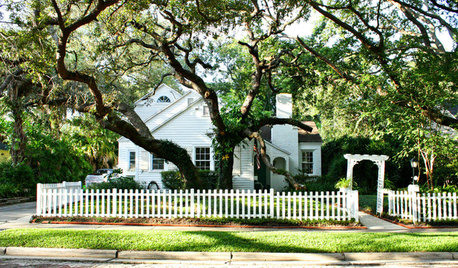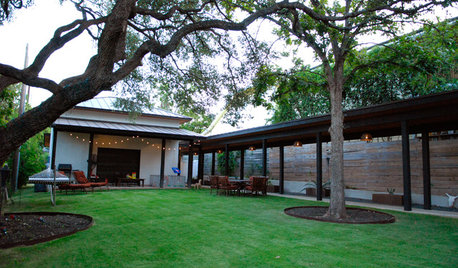Problem w/ young oak tree - pictures
miken
16 years ago
Featured Answer
Sort by:Oldest
Comments (28)
ken_adrian Adrian MI cold Z5
16 years agolast modified: 9 years agorhizo_1 (North AL) zone 7
16 years agolast modified: 9 years agoRelated Discussions
Young oak tree support removal & another question
Comments (3)the slack lines indicate it is doing nothing ... it was a large transplant.. and it was done to insure it remained upright ... and after 2 years.. it should be all set ... the wounds at your pix are healing.. i would ignore them ... though i wight flake off some of the bark toward the interior of the wound.. to insure there are not bugs in there ... do NOT further injure the callousing .... if that is the right term ... its getting near time.. to raise that canopy a bit ... so peeps on the sidewalk can walk by w/o injury ... i dont know about the timing of such for your oak.. in your area ... ken...See MoreHow to prune this wierd young Pin Oak?
Comments (5)I agree with Resin - First, cut all of the buckthorn back away from it so it gets more light! I would use long handled loppers and cut the buckthorn at ground level and when it sends up new shoots, carefully spray Roundup or Ortho Brush Killer on them. Then, perhaps right now before it begins growing, shorten the three very long side branches by a third or a half, so that the bulk of the crown is in the straightest stem. The one on the right. The main one will become much larger after the growing season is done and the side ones that are cut in half will continue to provide food during the growing season. If you live near a Walmart or a good garden center, buy one of the green plastic coated plant stakes - they come in various sizes. Push it in the ground by the "new leader" and loosely tie the leader so it will be straighter. The tree will "straighten" as it grows... I have done this with many different tree species with desired results. Pin Oak is a fast growing member of the red Oak family. Also, if you have deer / rabbits/ Voles, put a chicken wire or cut to size hardware cloth cage round the tree. ~ Gerry...See Morepin oaks: why does this tree look sick? problem help!
Comments (8)This is very common in subdivisions. For a particular tree, there is no remedy except a one-inch heading cut and replacement. The first picture I agree the plant is too deep. No remedy. Very common. Your builder cut corners. Sorry. The second picture shows no ill plant health at a distance. What it does show is inadequate space for these plants. There is no remedy except a one-inch heading cut and replacement. I also, in the foto, don't see a sidewalk on your side. Putting aside my urban planner lectures on why this is bad, this is an indicator of cutting corners, as is the pavement quality and rolled curb job (from here, their engineer failed to slope the grade adequately for anything greater than 5-yr precip) . Your side setback is still inadequate for these trees (shame on the city's planners). Nonetheless, this is still an indicator of fill and little if any OM, indicated by the lawn health. At least the spp. selection is OK I doubt you want to get a bobcat in there and fix the initial oversight. The alternative is to deal with it, as fert for trees is not a good way to spend your money. I suspect the second-hand trees and limited root growth are problematic and the remedies are in the 4 figures. The externalities are low now, but costs accrue yearly and the amortization has a high percentage. Dan...See MoreProblem w/ young Oak tree - pictures
Comments (7)It's hard to tell from the pics, but I, too, think it might be planted to deeply. To follow up with what Lou said, make sure you add the mulch after you've removed the soil from the root flare, and don't put the mulch all the way up to the trunk of the tree. Leave a space of a few inches without any mulch. Another concern is if you've used any weed and feed. Those are very bad for trees. The brown spots on the leaves look like a possible fungal disease, but it's not deadly, just ugly. You can treat with corn meal to help control that. Just apply feed grade corn meal at the rate of 20 pounds per 1000 square feet over the entire root zone, which extends beyond the canopy. Apply it more than once, say about 3 times, around 2 weeks to a month apart. Good luck. Sally...See Moremiken
16 years agolast modified: 9 years agotexasredhead
16 years agolast modified: 9 years agoalabamatreehugger 8b SW Alabama
16 years agolast modified: 9 years agotexasredhead
16 years agolast modified: 9 years agoalabamatreehugger 8b SW Alabama
16 years agolast modified: 9 years agobrandon7 TN_zone7
16 years agolast modified: 9 years agotexasredhead
16 years agolast modified: 9 years agobrandon7 TN_zone7
16 years agolast modified: 9 years agolou_spicewood_tx
16 years agolast modified: 9 years agobrandon7 TN_zone7
16 years agolast modified: 9 years agobrandon7 TN_zone7
16 years agolast modified: 9 years agojohn_w
16 years agolast modified: 9 years agobrandon7 TN_zone7
16 years agolast modified: 9 years agokatrina1
16 years agolast modified: 9 years agolou_spicewood_tx
16 years agolast modified: 9 years agoblueseatx
16 years agolast modified: 9 years agokatrina1
16 years agolast modified: 9 years agosarahbarah27
16 years agolast modified: 9 years agolou_spicewood_tx
16 years agolast modified: 9 years agobrandon7 TN_zone7
16 years agolast modified: 9 years agokatrina1
16 years agolast modified: 9 years agomiken
16 years agolast modified: 9 years agolou_spicewood_tx
16 years agolast modified: 9 years agosnappybob
16 years agolast modified: 9 years agolen511
16 years agolast modified: 9 years ago
Related Stories

ECLECTIC HOMESHouzz Tour: Problem Solving on a Sloped Lot in Austin
A tricky lot and a big oak tree make building a family’s new home a Texas-size adventure
Full Story
TREESGreat Design Plant: Southern Live Oak Offers an Unbeatable Canopy
Keep it dense or prune it for more light. No matter how you grow Quercus virginiana, it’s a majestic addition to its native landscape
Full Story
HOLIDAYSHouzz Call: Show Us Your Christmas Tree!
How lovely are your branches? Post a picture and share your stories
Full Story
TREESHow to Buy Healthy Trees and Shrubs
A healthy young plant with a strong form is more likely to do well in your yard. Here’s what to look for at the nursery
Full Story
KITCHEN OF THE WEEKKitchen of the Week: Goodbye, Honey Oak — Hello, Minty Green
After more than 30 years, the Kloesels revamped their space to reflect their rural country town and Victorian-style home
Full Story
GARDENING GUIDESTree Care: Common Tree Diseases and What to Do About Them
Learn to recognize trees that may be affected by diseases or pests so you can quickly take action
Full Story
FALL GARDENING6 Trees You'll Fall For
Don’t put down that spade! Autumn is the perfect time for planting these trees
Full Story
TREESHow to Protect Your Trees When You’re Remodeling or Building
Will your home be undergoing construction this year? Be sure to safeguard your landscape’s valuable trees
Full Story
SPRING GARDENING7 Spectacular and Practical Spring-Flowering Trees
Put on a beauteous show in the garden with a landscape tree awash in flowers — just do your homework first
Full Story
MOST POPULARHouzz Tour: Gracious Older Home Updated for a Young Family
A Texas designer lightens up and repurposes rooms, creating a welcoming space that suits this family’s casual lifestyle
Full Story



katrina1